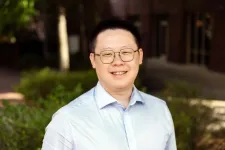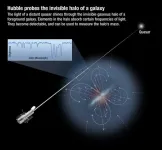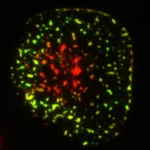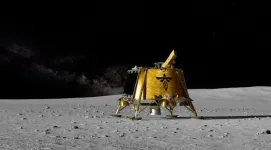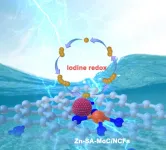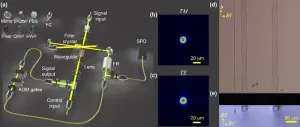(Press-News.org) Go faster, farther, more efficiently.
That’s the goal driving spacecraft propulsion engineers like Chen Cui, a new assistant professor at the University of Virginia School of Engineering and Applied Science. Cui is exploring ways to improve electric propulsion thrusters — a key technology for future space missions.
“In order to ensure the technology remains viable for long-term missions, we need to optimize EP integration with spacecraft systems,” Cui said.
Working with his former adviser, University of Southern California professor Joseph Wang, Cui published findings last month in Plasma Sources Science and Technology that provide fresh insights into electron kinetic behavior within plasma beams, perhaps revealing the “shape” of things to come.
The Future of Space Exploration
Cui, who joined the Department of Mechanical and Aerospace Engineering in the fall, focuses his research on understanding how electrons — tiny, fast-moving charged particles — behave in the plasma beams emitted by EP thrusters.
“These particles may be small, but their movement and energy play an important role in determining the macroscopic dynamics of the plume emitted from the electric propulsion thruster,” he said.
By studying these microscopic interactions, Cui aims to better understand how the plume of plasma emitted interacts with the spacecraft itself.
Electric propulsion works by ionizing a neutral gas, usually xenon, and then using electric fields to accelerate the resulting ions. The ions, now forming a high-speed plasma beam, push the spacecraft forward.
Compared to chemical rockets, EP systems are much more fuel-efficient, enabling spacecraft to travel farther while carrying less fuel. These systems are often powered by solar panels or small nuclear reactors, making them ideal for long missions in space, such as NASA's Artemis program, which aims to return humans to the moon, and eventually send astronauts to Mars and beyond.
However, the plume emitted by the thrusters isn’t just exhaust — it’s the lifeline of the entire propulsion system. If not well understood, the plume can cause unexpected problems. Some particles may flow backward toward the spacecraft, potentially damaging important components on the craft, such as solar panels or communication antennas.
“For missions that could last years, EP thrusters must operate smoothly and consistently over long periods of time,” Cui said. This means scientists and engineers must have a deep understanding of how the plasma plume behaves in order to prevent any potential damage.
What the Research Found
Cui specializes in building advanced computer simulations to study how plasma behaves in EP thruster plasma flows. These aren’t just any simulations. They’re powered by modern supercomputers and use a method called Vlasov simulation, an advanced “noise-free” computational method.
The electrons in an EP beam don’t behave exactly as predicted by simple models. They perform differently at different temperatures and speeds, creating distinct patterns.
Being able to precisely see the complexity of electron interactions, while factoring out data that confuse the bigger picture, is key.
“The electrons are a lot like marbles packed into a tube,” Cui said. “Inside the beam, the electrons are hot and move fast. Their temperature doesn’t change much if you go along the beam direction. However, if the ‘marbles’ roll out from the middle of the tube, they start to cool down. This cooling happens more in certain direction, the direction perpendicular the beam’s direction.”
In their most recent paper, they found the electron velocity distribution shows a near-Maxwellian [bell-curve-like] shape in the beam direction and what they describe as a “top-hat” profile in the transverse direction of the beam.
Additionally, Cui and Wang discovered that electron heat flux — the major way thermal energy moves through the EP plasma beam — primarily occurs along the beam’s direction, with unique dynamics that had not been fully captured in previous models.
Publication Information
“Vlasov Simulations of Electric Propulsion Beam,” C. Cui and J. Wang, Plasma Sources Science and Technology, vol. 33, no. 12, p. 125005, 2024.
At UVA Engineering, we are building a brighter future through engineering for the greater good. Our mission is to make the world a better place through bold research and world-class education, putting people at the center of innovation. Our vibrant, diverse community attracts outstanding students and faculty from around the world to our internationally recognized education and research programs, where we are making groundbreaking discoveries in fields including artificial intelligence, hypersonics, cancer research and more. UVA Engineering is part of the top-ranked University of Virginia and is distinguished by a community of care where collegiality, support and engineering ethics thrive.
END
New UVA professor’s research may boost next-generation space rockets
Chen Cui and co-author find hidden ‘shapes’ within EP plasma beams
2025-01-03
ELSE PRESS RELEASES FROM THIS DATE:
Multilingualism improves crucial cognitive functions in autistic children
2025-01-03
A new study from UCLA Health adds to the growing body of evidence on the cognitive benefits of speaking multiple languages, finding that multilingualism not only enhances general cognitive abilities but also may help reduce certain symptoms and bolster control of daily thoughts and actions in children with and without autism.
The study, published in the journal Autism Research, found parents of autistic and non-autistic children in multilingual households reported their children had stronger overall executive ...
The carbon in our bodies probably left the galaxy and came back on cosmic ‘conveyer belt’
2025-01-03
Link to full release:
https://www.washington.edu/news/2025/01/03/galaxy-carbon-conveyer-belt/
FROM: James Urton
University of Washington
206-543-2580
jurton@uw.edu
(Note: researcher contact information at the end)
For immediate release
Friday, Jan. 3, 2025
The carbon in our bodies probably left the galaxy and came back on cosmic ‘conveyer belt’
Life on Earth could not exist without carbon. But carbon itself could not exist without stars. Nearly all elements except hydrogen and ...
Scientists unveil surprising human vs mouse differences in a major cancer immunotherapy target
2025-01-03
Since its discovery in the 1990s, “programmed cell death protein 1,” or PD-1, has been regarded as a leading target in cancer treatments. A “checkpoint” receptor that often resides on the surface of immune system cells, the PD-1 molecule works as a type of off switch that keeps immune cells from attacking other cells.
After its discovery, which revolutionized oncology and earned a 2018 Nobel Prize, researchers developed new drugs to block PD-1 and unleash the body’s immune system to fight cancer. Yet treatments leveraging PD-1 are only effective in a small fraction of cancer patients, highlighting ...
NASA’s LEXI will provide X-ray vision of Earth’s magnetosphere
2025-01-03
A NASA X-ray imager is heading to the Moon as part of NASA's Artemis campaign, where it will capture the first global images of the magnetic field that shields Earth from solar radiation.
The Lunar Environment Heliospheric X-ray Imager, or LEXI, instrument is one of 10 payloads aboard the next lunar delivery through NASA’s CLPS (Commercial Lunar Payload Services) initiative, set to launch from the agency's Kennedy Space Center in Florida no earlier than mid-January, with Firefly Aerospace’s Blue Ghost Lander. The instrument will support ...
A successful catalyst design for advanced zinc-iodine batteries
2025-01-03
Aqueous zinc-ion batteries (ZIBs) have attracted extensive attention due to their high safety, abundant reserves, and environmental friendliness. Iodine with high abundance in seawater (55 μg L−1) is highly promising to fabricate zinc-iodine batteries due to high theoretical capacity (211 mAh g−1) and appropriate redox potential (0.54 V). However, the low electrical conductivity of iodine hinders the redox conversion for the efficient energy storage process with zinc. Additionally, the formed soluble polyiodides are prone to migirate to Zn anode, leading to capacity degration and ...
AMS Science Preview: Tall hurricanes, snow and wildfire
2025-01-03
The American Meteorological Society continuously publishes research on climate, weather, and water in its 12 journals. Many of these articles are available for early online access–they are peer-reviewed, but not yet in their final published form.
Below is a selection of articles published early online recently. Some articles are open-access; to view others, members of the media can contact kpflaumer@ametsoc.org for press login credentials.
JOURNAL ARTICLES
The Impact of Snowoff Timing and Associated Atmospheric Drivers on the Alaska Wildfire Season
Earth Interactions
Earlier ...
Study finds 25% of youth experienced homelessness in Denver in 2021, significantly higher than known counts
2025-01-03
AURORA, Colo. (Jan. 3, 2025) – A first of its kind study, published today in Pediatrics, has provided full-picture assessment of youth homelessness in Denver, Colorado. The findings reveal that nearly 25% of youth in Denver experienced homelessness or housing insecurity in 2021, with rates increasing almost every year since 2017.
Researchers across Colorado, led by Josh Barocas, MD and resident Matthew Westfall, MD of the University of Colorado Anschutz Medical Campus, combined multiple data sources for youth aged 14 to 17 in the City of Denver, to estimate the total number ...
Integrated spin-wave quantum memory
2025-01-03
The synchronization function of quantum memories can be employed to connect multiple short-distance entanglement into long-distance entanglement, so that to effectively overcome the transmission loss of photons and enable the construction of large-scale quantum networks. The rare-earth ions doped crystals is a candidate system for implementation of quantum memories with excellent performances, and integrated solid-state quantum memories have been successfully demonstrated with various micro- and nano- fabrication techniques.
All previous demonstrations of integrated quantum memories for light are limited to the storage ...
Brain study challenges long-held views about Parkinson's movement disorders
2025-01-03
University of Arizona researchers have revealed new insights into one of the most common complications faced by Parkinson's disease patients: uncontrollable movements that develop after years of treatment.
Parkinson's disease – a neurological disorder of the brain that affects a person's movement – develops when the level of dopamine, a chemical in the brain that's responsible for bodily movements, begins to dwindle. To counter the loss of dopamine, a drug called levodopa is administered and later gets converted into dopamine in the brain. However, long-term treatment with levodopa induces ...
Mental disorders among offspring prenatally exposed to systemic glucocorticoids
2025-01-03
About The Study: In this cohort study, prenatal exposure to glucocorticoids was associated with higher risk of some mental disorders. These data support continued caution in the use of glucocorticoids in pregnant people.
Corresponding Author: To contact the corresponding author, Kristina Laugesen, PhD, email kristina.laugesen@clin.au.dk.
To access the embargoed study: Visit our For The Media website at this link https://media.jamanetwork.com/
(doi:10.1001/jamanetworkopen.2024.53245)
Editor’s Note: Please see the article for additional information, including other authors, author contributions ...
LAST 30 PRESS RELEASES:
University of Phoenix College of Doctoral Studies releases white paper on AI-driven skilling to reduce burnout and restore worker autonomy
AIs fail at the game of visual “telephone”
The levers for a sustainable food system
Potential changes in US homelessness by ending federal support for housing first programs
Vulnerability of large language models to prompt injection when providing medical advice
Researchers develop new system for high-energy-density, long-life, multi-electron transfer bromine-based flow batteries
Ending federal support for housing first programs could increase U.S. homelessness by 5% in one year, new JAMA study finds
New research uncovers molecular ‘safety switch’ shielding cancers from immune attack
Bacteria resisting viral infection can still sink carbon to ocean floor
Younger biological age may increase depression risk in older women during COVID-19
Bharat Innovates 2026 National Basecamp Showcases India’s Most Promising Deep-Tech Ventures
Here’s what determines whether your income level rises or falls
SCIE indexation achievement: Celebrate with Space: Science & Technology
Children’s Hospital Colorado performs region’s first pediatric heart and liver dual organ transplant
Australian team discover why quantum computers have memory problems over time
What determines the fate of a T cell?
Candida auris: genetic process revealed which could be treatment target for deadly fungal disease
Groundbreaking discovery turns household plastic recycling into anti-cancer medication
Blocking a key inflammatory pathway improves liver structure and vascular function in cirrhosis, study finds
Continuous spread: Raccoon roundworm detected in nine European countries
HKUST Engineering researchers developed a novel photodetector to enhance the performance of on-chip light monitoring
Strategic river sensors could have forewarned of Texas Camp flood disaster
Drone sampling of whale breath reveals first evidence of potentially deadly virus in Arctic
Roman soldiers defending Hadrian’s Wall infected by parasites, study finds
Pinochet’s prisoners were tormented with music but still found solace in it, a new book reveals
Fertility remains high in rural Tanzania despite access to family planning
AI-assisted device can improve autism care access
Kinetic careers
Uncovering how parasitic plants avoid attacking themselves to improve crop resistance
Nanoparticle vaccine strategy could protect against Ebola and other deadly filoviruses
[Press-News.org] New UVA professor’s research may boost next-generation space rocketsChen Cui and co-author find hidden ‘shapes’ within EP plasma beams
